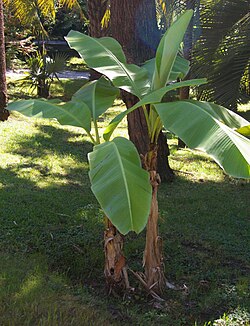| Musa basjoo | |
|---|---|
 | |
| Scientific classification | |
| Kingdom: | Plantae |
| Clade: | Tracheophytes |
| Clade: | Angiosperms |
| Clade: | Monocots |
| Clade: | Commelinids |
| Order: | Zingiberales |
| Family: | Musaceae |
| Genus: | Musa |
| Section: | Musa sect. Musa |
| Species: | M. basjoo |
| Binomial name | |
| Musa basjoo Siebold & Zucc. ex Iinuma | |

Musa basjoo, known variously as Japanese banana, [2] Japanese fiber banana [3] or hardy banana, is a species of flowering plant belonging to the banana family Musaceae. It was previously thought to have originated in the Ryukyu Islands of Japan, from where it was first described in cultivation, [4] but is now known to have originated in the subtropical southern Chinese province of Sichuan. [3] [5] Its specific name is derived from its Japanese common name, bashō (芭蕉).
